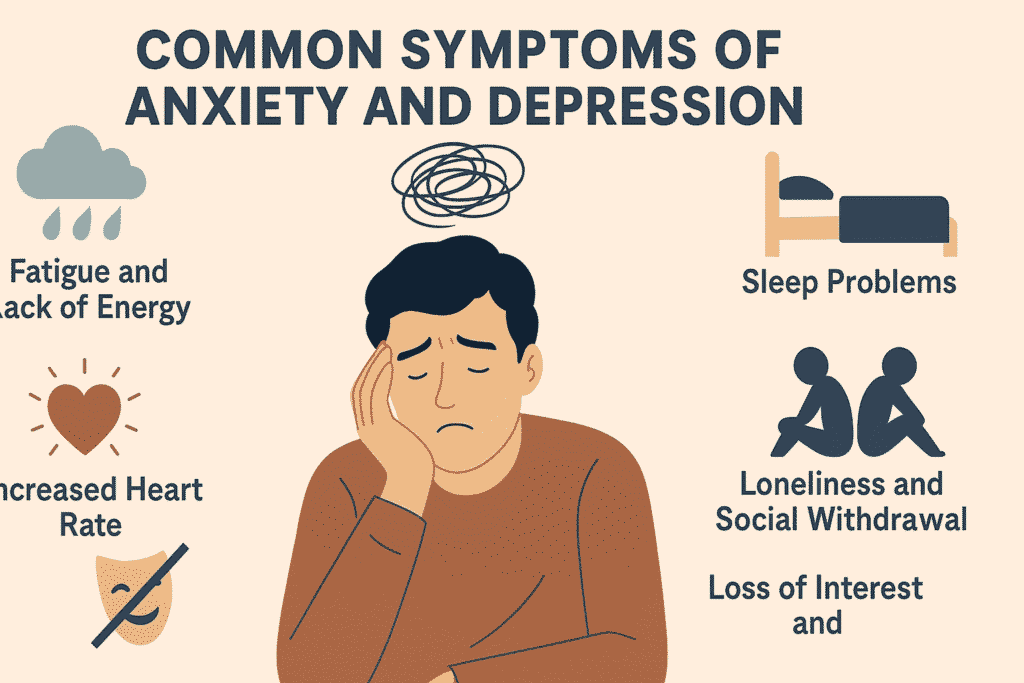Anxiety and Depression are the most deadly diseases in our time. We live in the era of the three Ms—Market, Media, and Mobile. These forces now dictate the rhythms of our lives, turning our existence increasingly mechanical.
People are drifting further apart, disconnected from real human interactions. In the void left by this disconnection, anxiety and depression quietly creep into our lives, often unnoticed, often unspoken.
According to the World Health Organization, about 264 million people worldwide suffer from depression every year. On top of that, anxiety disorders affect even more. Sometimes these two conditions operate separately, but very often, they work in tandem, casting a long shadow on a person’s life. The most dangerous aspect? Many people don’t even realize that they are already in the grip of these conditions.
So the question naturally arises—how can one recognize if they or someone they love is struggling with anxiety and depression? What do the symptoms really look like?
This article is for those in the United States who have long blamed themselves for how they feel. It’s for the people who carry an invisible weight of guilt on their hearts. Together, we’ll break down the common signs of anxiety and depression, draw on insights from world-renowned mental health experts, and explore how these symptoms echo through everyday life.

Overthinking and Persistent Worry
Let’s begin with overthinking. One of the hallmark signs of anxiety and depression is being trapped in a relentless loop of thoughts. These thoughts may be about a potential future disaster, personal failures, or even worrying about how others perceive them. Sometimes, the mind just spins—there’s no real reason, no trigger—yet the cycle continues.
It becomes nearly impossible to press the mental brakes. You may even lose track of what you were originally thinking about. People in this state often start blaming themselves for everything going wrong—the job stress, business losses, or family arguments. They try to hide their internal worry by pointing fingers at external circumstances.
Dr. Elena Torres, a professor of psychiatry at Harvard Medical School, says, “When someone spends most of their day consumed by worry about the future or immersed in self-blame, that’s a primary sign of anxiety. These worries are often irrational and uncontrollable.”
So here’s a question to leave with you—what is the future, really?
Fatigue and Lack of Energy Links to Anxiety and Depression
One of the shared symptoms of both anxiety and depression is persistent fatigue. And this isn’t just physical exhaustion—it’s a mental fog, a heavy, draining feeling that doesn’t go away even after rest.
People may spend the entire day in bed and still feel worn out. The body demands more rest, the back starts to ache after being up for a while, and nothing seems to recharge them. These too are signs.
In one study, it was found that people with such symptoms begin to experience weakening in certain parts of their body. Eventually, they lose sensation in those areas without even realizing it. If left unchecked, this kind of fatigue can push someone closer to life-threatening outcomes.
Research from the renowned Mayo Clinic highlights that fatigue is such a prominent marker of depression that it is used as a key diagnostic indicator. In other words, fatigue often signals the arrival of other debilitating symptoms. Over time, the affected person may lose a significant amount of weight and strength.

Sleep Problems
Both insomnia and hypersomnia can signal anxiety and depression. Especially in city life, sleep disturbances are rampant. The bright lights, the nonstop screens—they make it hard to disconnect. Add the constant noise, and you’ve got the perfect storm.
Some people can’t fall asleep without noise now, while others lie awake because their thoughts won’t let them rest. The mind floods with worry when the body tries to rest. Even switching positions and fluffing pillows doesn’t help.
Then there are those who sleep all day and still feel unrested, waking up even more exhausted than before.
Former NIMH director Dr. Thomas Insel said, “Changes in sleep patterns—particularly insomnia—are among the earliest indicators of depression. It’s often the first sign that mental balance is slipping.”
And we know how society treats someone who’s lost their mental balance. That fear adds yet another layer of worry.
Loneliness and Social Withdrawal
People suffering from depression often distance themselves from family and friends. They avoid small gatherings, ignore phone calls, and suppress their feelings—this is how social withdrawal takes root.
Because they don’t understand their own condition, they begin to think that no one else understands them either. They’re not aware that they themselves are unable to understand or express what they’re going through. This leads to further disconnection.
And since family members are the closest, they’re often the first ones pushed away. Misunderstandings grow. Eventually, the affected person may prefer living separately.
Dr. Martin Seligman, founder of Positive Psychology, puts it simply: “Social connection is a pillar of mental health. Isolation means you’re cutting yourself off from your psychological support systems.”
Loss of Interest and Joylessness
Things that once brought joy no longer excite. Favorite hobbies, favorite meals, spending time with loved ones—all begin to feel empty. This symptom is known as anhedonia and is considered one of the core signs of depression. Studies show that around 70% of people with depression experience this.
A lack of interest can also take a toll on physical relationships. Natural sexual functioning between partners suffers—premature ejaculation, lack of arousal, or physical detachment may occur. Over time, this strains the relationship, making it harder to sustain.
Without intimacy and connection, relationships start to crumble. Marital conflicts, emotional stress, and extramarital affairs often follow, all of which can evolve into severe relationship crises.

Physical Symptoms and Increased Heart Rate
Anxiety and Depression leaves a very real mark on the body. Rapid heartbeat, excessive sweating, stomach issues, dizziness, or cold limbs—these are some of the common physical symptoms.
Dr. Jon Kabat-Zinn, pioneer of Mindfulness-Based Stress Reduction, explains, “The mind and body are inseparable. When fear or anxiety settles in the mind, the body receives that signal too. If we don’t recognize this dual response, the person may begin to think they’re physically ill, which intensifies the panic.”
Low Self-Esteem and Self-Blame
“I can’t do anything right.” “It’s all my fault.” These thoughts are at the core of depression. People begin questioning their very existence, spiraling into self-loathing and plummeting confidence.
The environment around us adds fuel to the fire. We live in an age of invisible competition. If someone falls behind, they become the target of ridicule. These comments slowly eat away at a person’s strength, until they start to believe they are worthless.
Eventually, even while surrounded by people, they feel completely alone.
Dr. Aaron Beck, known as the father of cognitive therapy, said, “Depressed individuals are caught in a self-constructed cycle of failure. They develop a bleak view of their life and self-worth.”
Suicidal Thoughts and Intent
The most dangerous symptom of anxiety and depression is suicidal ideation. People often express thoughts like, “Life is meaningless,” or “It would be better if everything just ended.”
According to WHO, one person dies by suicide every 40 seconds globally, and most of them never receive treatment.
In the blink of an eye, a small mistake can lead to a life-ending decision.
Dr. Kevin Hines, a suicide survivor and now a mental health advocate, says, “When someone says, ‘I don’t want to live anymore,’ we need to take it seriously. That’s a silent cry for help.”
In this ruthless world driven by profit, such cries are becoming more frequent. But amid the chaos, they’re drowned out. So many quietly choose to leave.
Final Thoughts
Anxiety and depression are two distinct mental conditions, yet their symptoms often overlap. They leave subtle yet deep imprints on the body, mind, and behavior. Recognizing the signs early is the key to healing. And healing can begin with a conversation—with a trusted friend, or with a mental health professional.
If we learn to understand why someone might withdraw, or why they lie awake at night, we might just be able to save a few lives.
Read More : Why More People Are Reaching 100 Worldwide
